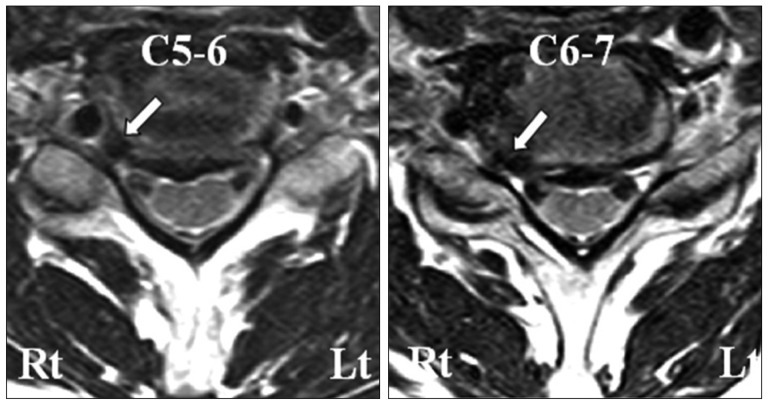J Korean Neurosurg Soc.
2013 Feb;53(2):125-128. 10.3340/jkns.2013.53.2.125.
Cervical Spinal Epidural Hematoma Following Cervical Posterior Laminoforaminotomy
- Affiliations
-
- 1Department of Neurosurgery, Wooridul Spine Hospital, Seoul, Korea.
- 2Department of Neurosurgery, Spine Center, Seoul St. Mary's Hospital, The Catholic University of Korea College of Medicine, Seoul, Korea. mddavidk@dreamwiz.com
- KMID: 2190692
- DOI: http://doi.org/10.3340/jkns.2013.53.2.125
Abstract
- A 65-year-old man who had lateral cervical disc herniation underwent cervical posterior laminoforaminotomy at C5-6 and C6-7 level right side. During the operation, there was no serious surgical bleeding event. After operation, he complained persistent right shoulder pain and neck pain. Repeated magnetic resonance image (MRI) showed diffuse cervical epidural hematoma (EDH) extending from C5 to T1 level right side and spinal cord compression at C5-6-7 level. He underwent exploration. There was active bleeding at muscular layer. Muscular active bleeding was controlled and intramuscular hematoma was removed. The patient's symptom was reduced after second operation. Symptomatic postoperative spinal EDH requiring reoperation is rare. Meticulous bleeding control is important before wound closure. In addition, if patient presents persistent or aggravated pain after operation, rapid evaluation using MRI and second look operation is needed as soon as possible.
Keyword
MeSH Terms
Figure
Reference
-
1. Adamson TE. Microendoscopic posterior cervical laminoforaminotomy for unilateral radiculopathy : results of a new technique in 100 cases. J Neurosurg. 2001; 95(1 Suppl):51–57. PMID: 11453432.
Article2. Awad JN, Kebaish KM, Donigan J, Cohen DB, Kostuik JP. Analysis of the risk factors for the development of post-operative spinal epidural haematoma. J Bone Joint Surg Br. 2005; 87:1248–1252. PMID: 16129751.
Article3. Henderson CM, Hennessy RG, Shuey HM Jr, Shackelford EG. Posterior-lateral foraminotomy as an exclusive operative technique for cervical radiculopathy : a review of 846 consecutively operated cases. Neurosurgery. 1983; 13:504–512. PMID: 6316196.
Article4. Holly LT, Moftakhar P, Khoo LT, Wang JC, Shamie N. Minimally invasive 2-level posterior cervical foraminotomy : preliminary clinical results. J Spinal Disord Tech. 2007; 20:20–24. PMID: 17285047.5. Korinth MC, Krüger A, Oertel MF, Gilsbach JM. Posterior foraminotomy or anterior discectomy with polymethyl methacrylate interbody stabilization for cervical soft disc disease : results in 292 patients with monoradiculopathy. Spine (Phila Pa 1976). 2006; 31:1207–1214. discussion 1215-1216. PMID: 16688033.
Article6. Kou J, Fischgrund J, Biddinger A, Herkowitz H. Risk factors for spinal epidural hematoma after spinal surgery. Spine (Phila Pa 1976). 2002; 27:1670–1673. PMID: 12163731.
Article7. Krupp W, Schattke H, Müke R. Clinical results of the foraminotomy as described by Frykholm for the treatment of lateral cervical disc herniation. Acta Neurochir (Wien). 1990; 107:22–29. PMID: 2096604.
Article8. Kumar GR, Maurice-Williams RS, Bradford R. Cervical foraminotomy : an effective treatment for cervical spondylotic radiculopathy. Br J Neurosurg. 1998; 12:563–568. PMID: 10070468.
Article9. Lawton MT, Porter RW, Heiserman JE, Jacobowitz R, Sonntag VK, Dickman CA. Surgical management of spinal epidural hematoma : relationship between surgical timing and neurological outcome. J Neurosurg. 1995; 83:1–7. PMID: 7782824.
Article10. Lee DY, Lee SH. Cervicothoracic spinal epidural hematoma after anterior cervical spinal surgery. J Korean Neurosurg Soc. 2010; 48:541–543. PMID: 21430984.
Article11. Neo M, Sakamoto T, Fujibayashi S, Nakamura T. Delayed postoperative spinal epidural hematoma causing tetraplegia. Case report. J Neurosurg Spine. 2006; 5:251–253. PMID: 16961087.12. Ruetten S, Komp M, Merk H, Godolias G. Full-endoscopic cervical posterior foraminotomy for the operation of lateral disc herniations using 5.9-mm endoscopes : a prospective, randomized, controlled study. Spine (Phila Pa 1976). 2008; 33:940–948. PMID: 18427313.
Article13. Semmes RE, Murphey F. The syndrome of unilateral rupture of the sixth cervical intervertebral disc. JAMA. 1943; 121:1209–1214.
Article14. Uribe J, Moza K, Jimenez O, Green B, Levi AD. Delayed postoperative spinal epidural hematomas. Spine J. 2003; 3:125–129. PMID: 14589226.
Article15. Williams RW. Microcervical foraminotomy. A surgical alternative for intractable radicular pain. Spine (Phila Pa 1976). 1983; 8:708–716. PMID: 6320471.
Article16. Witzmann A, Hejazi N, Krasznai L. Posterior cervical foraminotomy. A follow-up study of 67 surgically treated patients with compressive radiculopathy. Neurosurg Rev. 2000; 23:213–217. PMID: 11153550.
Article
- Full Text Links
- Actions
-
Cited
- CITED
-
- Close
- Share
- Similar articles
-
- Acute Cervical Subdural Hematoma with Quadriparesis after Cervical Transforaminal Epidural Block
- A Case of Spontaneous Cervical Spinal Epidural Hematoma: Case Report
- Immediate Revision Surgery due to Post-Anterior Cervical Discectomy and Fusion (ACDF) Spinal Epidural Hematoma
- Spontaneous Cervical Epidural Hematomas in Healthy Young Adults: Case Report
- Cervicothoracic Spinal Epidural Hematoma after Anterior Cervical Spinal Surgery





